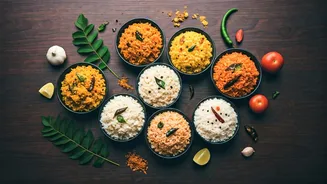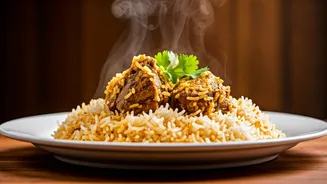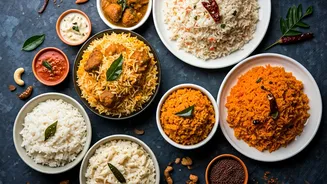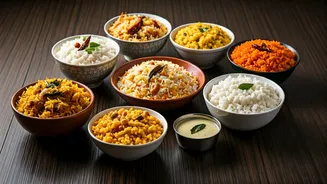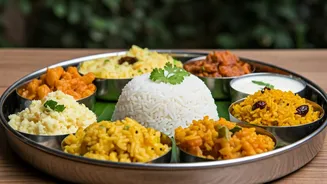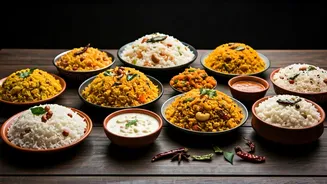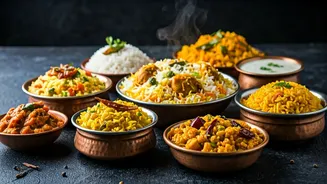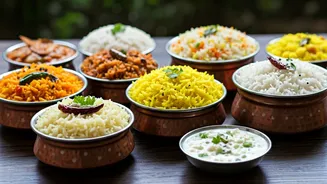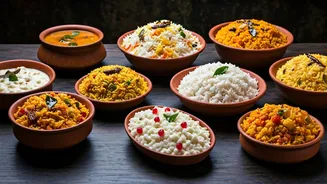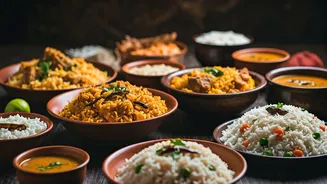Aromatic Biryani Bliss
Biryani, a fragrant rice dish, reigns supreme in South Indian cuisine, with various regional twists. The Hyderabadi Biryani, known for its rich flavors,
layers marinated meat (usually chicken or mutton) with fragrant basmati rice, saffron, and aromatic spices. Chennai's Ambur Biryani offers a distinctive taste with a unique blend of spices and tender meat. Malabar Biryani, from Kerala, often uses a shorter-grain rice, and its preparation style imparts a unique aroma. Each biryani tells a story of culinary heritage, with variations in spices, meat, and rice defining the regional tastes. The cooking process, whether dum-style (slow cooking) or on a stovetop, ensures the flavors meld together perfectly, creating a memorable dining experience. Biryani is not just a dish; it's an event, often prepared for special occasions and celebrations, reflecting the region's love for grand feasts.
Tamarind Rice Temptation
Tamarind Rice, or Pulihora, is a tangy and flavorful dish. It’s a staple in South Indian households, particularly in Andhra Pradesh and Telangana. The rice is cooked and then mixed with a tamarind paste, spices, and often peanuts or cashews for texture. The sourness from the tamarind, balanced by the spices and the crunch of the nuts, makes this dish a treat. The preparation typically involves sautéing mustard seeds, urad dal, and red chilies in oil, followed by the addition of the tamarind paste. Once the mixture thickens, it's combined with the cooked rice. It is a quick and easy meal, popular for its vibrant taste and simplicity. Tamarind rice is perfect for travel, picnics, and festive occasions, reflecting the adaptability and love for flavor of South Indian cuisine.
Lemon Rice Zest
Lemon Rice, or Chitranna, is a refreshing dish. It is particularly popular in Karnataka and Tamil Nadu. The process starts with tempering mustard seeds, urad dal, chana dal, and curry leaves in oil. Lemon juice and turmeric are added to this mix, creating a vibrant base. Cooked rice is then mixed with this tempering. The result is a bright yellow, zesty rice dish, often garnished with peanuts or cashews for added texture. Lemon rice's simplicity makes it a quick option, perfect for breakfast, lunch, or even as a side dish. The dish's tanginess provides a refreshing contrast to heavier meals, making it a popular choice during the hot summer months. It is an ideal example of how simple ingredients can be combined to create a delicious and satisfying meal.
Coconut Rice Creaminess
Coconut Rice, or Thengai Sadam, captures the flavors of the tropics, especially in Kerala and coastal regions of Tamil Nadu. The dish involves cooking rice with coconut milk, which imparts a creamy texture and subtle sweetness. The rice is then tempered with mustard seeds, urad dal, curry leaves, and sometimes green chilies. The result is a fragrant and flavorful rice dish with a rich coconut taste. It’s often served with vegetable curries or sambar. Its creamy texture and delicate sweetness make it a favorite for special occasions. Coconut rice showcases the use of local ingredients and is a celebration of the abundant coconut groves found in South India. It is a dish that highlights the region's coastal influence and culinary creativity.
Curd Rice Comfort
Curd Rice, or Thayir Sadam, provides a cooling and comforting experience, especially during the warm months. Cooked rice is mixed with curd (yogurt) and seasoned with salt, and sometimes with a tempering of mustard seeds, green chilies, and curry leaves. It can be served plain or garnished with fresh coriander. The dish is a staple in many South Indian homes, known for its digestive properties and light nature. It’s often served after a spicy meal to soothe the palate. Curd rice is a symbol of simplicity and nourishment, offering a balance to the fiery flavors of other South Indian dishes. It represents a mindful approach to eating, providing a light, yet satisfying, meal.
Pongal Celebration
Pongal comes in different varieties, sweet or savory, and is particularly significant during the Pongal festival. Ven Pongal is the savory version. It's prepared with rice and moong dal, cooked together with spices like ginger, cumin, and pepper. It's often tempered with cashews and curry leaves. Sweet Pongal, or Chakara Pongal, is made with rice, jaggery, and ghee, often flavored with cardamom and nuts. Both versions are comforting and nutritious, representing abundance and prosperity. The dish has cultural significance and is an integral part of festive celebrations, reflecting the region's traditions and the importance of harvest. Pongal is more than just a dish; it's a celebration of community and gratitude for nature's bounty.
Bisibelebath Fusion
Bisibelebath, a spiced rice dish, is a Karnataka specialty. It features rice, lentils, vegetables, and a special blend of spices. The dish is cooked together, creating a flavorful and satisfying meal. The preparation involves toasting spices, grinding them into a powder, and then combining it with the rice, lentils, and vegetables. Tamarind pulp adds a tangy touch. Bisibelebath is known for its complex flavors and hearty nature, and it often includes vegetables like carrots, beans, and peas. The dish is a complete meal, offering a balance of carbohydrates, proteins, and vitamins, and often served with boondi and potato chips. It stands as a testament to the region's innovation, blending different ingredients to create something truly delicious and unique.
Tomato Rice Delight
Tomato Rice is a simple yet flavorful dish. It features rice cooked with tomatoes, onions, and spices, resulting in a slightly tangy and savory flavor profile. The dish begins with sautéing onions and tomatoes until they soften, then adding spices like red chili powder, turmeric, and coriander powder. Rice is then added and cooked with water until tender. It is often garnished with fresh coriander leaves. Tomato Rice is a versatile dish, perfect as a quick lunch or dinner option. It showcases the ability of South Indian cuisine to use simple ingredients to create flavorful and comforting meals. It can be served with raita or papadums for a balanced meal, highlighting the blend of flavors and textures that define South Indian cooking.
